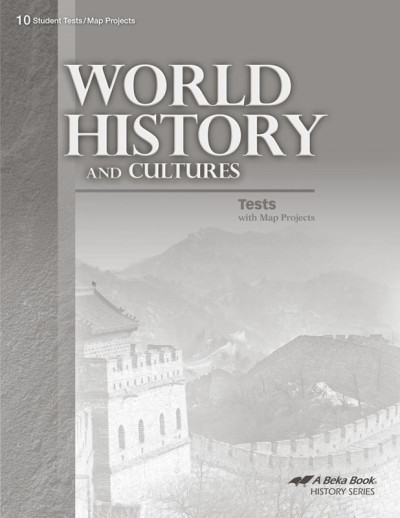We use cookies to make your experience better. To comply with the new e-Privacy directive, we need to ask for your consent to set the cookies. Learn more.
World History and Cultures in Christian Perspective Student Test and Map Book
Includes 12 tests consisting of essay questions, multiple choice, true/false, matching, and short answer. There are also 2 nine-week exams, as well as a semester and final exam. Map projects include labeling political and physical features on maps that correspond with the World History and Cultures textbook. Answers are sold separately.
Knowing the world's history and geography will contribute to a more mature understanding of the world and appreciation for God's providence in accomplishing His purposes. These prepared tests help you measure your teen's learning and understanding. In addition, as he labels and studies the physical features and countries and capitals of the world in the map projects, he will learn the places of history and world events.
The tests are correlated with the text World History and Cultures in Christian Perspective, 3rd ed.; World History and Cultures Quizzes; and World History and Cultures in Christian Perspective Teacher Edition, which includes the curriculum/lesson plans and "pop" reading quizzes. Answers and grading guidance for the test and map project book are sold separately in World History and Cultures Test/Map Project Key. Grade 10.
Product Features
* Essay questions develop critical thinking skills as your teen must explain historical details and articulate their significance to the present or identify major influences or consequences. A biblical worldview will be strengthened as he discusses false philosophies and their effects.
* A variety of question formats on the tests such as multiple choice, modified true/false, matching, and short answer holds your teen's interest and verifies whether he understands a concept, no matter how it is presented.
* Testing every three weeks (for a total of 12 tests) provides vital reinforcement of learning and an opportunity for your evaluation of your teen's comprehension.
* Two nine-week exams and semester and final exams further reinforce the concepts learned throughout the year.
* Since each test clearly specifies the sections covered, adjusting a test to your schedule is easy.
* The 8 map projects give your teen valuable hands-on practice in identifying the places of world history. Maps incorporate physical (e.g., rivers, mountain chains, deserts) and political (countries and capitals) features of the Middle East, Asia, Africa, Europe, North America, South America, Australia and New Zealand, and the entire world.
* The gray-scale maps in the map projects correspond to the colored maps in the textbook, preventing confusion and frustration in identifying the locations.
History is important. As children learn about past events and how such things relate to current issues, it helps them to understand societies and become better citizens. Abeka's history courses present history from a biblical perspective with a conservative, patriotic view. As students study our country, the world, as well as forms of government and citizenship, they develop a deeper understanding of history and learn about heroes showing bravery, courage, and diligence. Geography is also interwoven into the lessons, so students can make connections to the history they are studying (some grade levels have a separate workbook and answer key for map activities).
Taking a traditional approach, softcover Student Textbooks are in full color and written in an understandable format for each age group. Tests and quizzes are available to provide assessments. Grades 1-4 pivot toward the study of America and geography, giving students a solid foundation of American history and the great people who have helped shape our country in a positive manner. Grades 5-8 go into more detail about both world and American history along with geography, as students learn about the Eastern Hemisphere in grade 5 and the Western Hemisphere in grade 6. Grade 7 is an overview of world history and grade 8 is a United States history course. High school courses cover geography, world history, US history, American government, and economics.
There are several components to aid in the teaching of these courses. Teacher Editions have reduced-sized student pages, along with comprehension or discussion questions and detailed information on teaching the lesson. Curriculum Lesson Plans are (lesson plan) guides for the teacher and include enrichment activities. Answer Keys to the student textbook provide answers to Section and Chapter Review questions. Several resources are also available for grades 4-8 as support materials: My State Notebook (grade 4), Nation Notebook (grades 4-6), Nifty-Fifty Flashcards (grades 4-8), and Eastern (grades 5-8) and Western (grades 6-8) Hemisphere Map Skill Cards. Novels and biographies are suggested as additional reading material in certain grade levels.
Abeka provides a solid, grade leveled study of history that incorporates a biblical view with a focus on American patriotism. Students will see God's hand in history and benefit from learning about past events so they can impact the future in a useful way.
| Product Format: | Paperback |
|---|---|
| Brand: | A Beka Book |
| Grade: | 10 |
| Length in Inches: | 11 |
| Width in Inches: | 8.5 |
| Height in Inches: | 0.25 |
| Weight in Pounds: | 0.45 |

